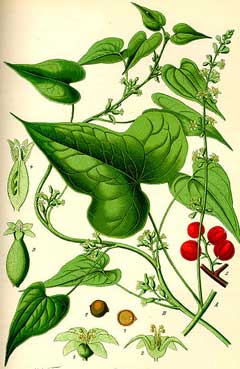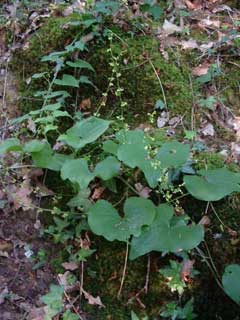 |
|
http://commons.wikimedia.org/wiki/File:Illustration_Tamus_communis0.jpg |
 |
|
Translate this page:
Summary
Physical Characteristics

 Tamus communis is a PERENNIAL CLIMBER growing to 3.5 m (11ft 6in) at a medium rate.
Tamus communis is a PERENNIAL CLIMBER growing to 3.5 m (11ft 6in) at a medium rate.
See above for USDA hardiness. It is hardy to UK zone 5. It is in flower from May to July, and the seeds ripen from September to November. The species is dioecious (individual flowers are either male or female, but only one sex is to be found on any one plant so both male and female plants must be grown if seed is required). and is pollinated by Bees, flies. The plant is not self-fertile.
Suitable for: light (sandy), medium (loamy) and heavy (clay) soils, prefers well-drained soil and can grow in heavy clay soil. Suitable pH: mildly acid, neutral and basic (mildly alkaline) soils. It can grow in semi-shade (light woodland) or no shade. It prefers moist soil. The plant can tolerates strong winds but not maritime exposure.
UK Hardiness Map
US Hardiness Map
Synonyms
Plant Habitats
Woodland Garden Dappled Shade; Shady Edge; Hedgerow;
Edible Uses
Edible Parts: Leaves Shoots
Edible Uses:
Young shoots - cooked[2, 4, 61, 65]. A decidedly bitter flavour[7]. An asparagus substitute, it is best if the water is changed once whilst cooking[115]. See notes at top of the page regarding possible toxicity.
References More on Edible Uses
Medicinal Uses
Plants For A Future can not take any responsibility for any adverse effects from the use of plants. Always seek advice from a professional before using a plant medicinally.
Antiecchymotic Antirheumatic Cathartic Diuretic Emetic Haemolytic Poultice Rubefacient
The root is antiecchymotic, diuretic, emetic, haemolytic and rubefacient[4, 7, 9]. Use with caution, the plant is rich in saponins, has a very powerful cathartic affect and ranks as a dangerous irritant poison[4, 7]. It is not normally used internally, but the macerated root is applied externally as a poultice to bruises, rheumatic joints etc[4, 7]. This should not be done without expert advice since it can cause painful blisters[9]. The root is used fresh[9] or can be harvested in the autumn and dried for later use[7].
References More on Medicinal Uses
The Bookshop: Edible Plant Books
Our Latest books on Perennial Plants For Food Forests and Permaculture Gardens in paperback or digital formats.

Edible Tropical Plants
Food Forest Plants for Hotter Conditions: 250+ Plants For Tropical Food Forests & Permaculture Gardens.
More

Edible Temperate Plants
Plants for Your Food Forest: 500 Plants for Temperate Food Forests & Permaculture Gardens.
More

More Books
PFAF have eight books available in paperback and digital formats. Browse the shop for more information.
Shop Now
Other Uses
References More on Other Uses
Cultivation details
Requires a moist well-drained fertile soil[17]. A climbing plant, the weak stems support themselves by twining around other plants and are capable of growing quite high up into shrubs and trees[4]. Dioecious. Male and female plants must be grown if seed is required.
References Carbon Farming Information and Carbon Sequestration Information
Temperature Converter
Type a value in the Celsius field to convert the value to Fahrenheit:
Fahrenheit:
The PFAF Bookshop
Plants For A Future have a number of books available in paperback and digital form. Book titles include Edible Plants, Edible Perennials, Edible Trees,Edible Shrubs, Woodland Gardening, and Temperate Food Forest Plants. Our new book is Food Forest Plants For Hotter Conditions (Tropical and Sub-Tropical).
Shop Now
Plant Propagation
Seed - sow in a cold frame in early spring or as soon as the seed is ripe in the autumn. Prick out the seedlings into individual pots once they are large enough to handle, and plant out in the summer or in late spring of the following year.
Other Names
If available other names are mentioned here
Native Range
TEMPERATE ASIA: Iran, Iraq, Israel, Jordan, Lebanon, Syria, Turkey, Russian Federation-Ciscaucasia (Ciscaucasia), Armenia, Azerbaijan, Georgia, Russian Federation (Dagestan) EUROPE: United Kingdom, Austria, Belgium, Switzerland, Germany, Hungary, Ukraine (incl. Krym), Former Yugoslavia, Albania, Bulgaria, Greece (incl. Crete), Italy (incl. Sardinia, Sicily), Romania, France (incl. Corsica), Portugal AFRICA: Spain (Canarias), Portugal (Madeira Islands), Algeria, Morocco, Tunisia
Weed Potential
Right plant wrong place. We are currently updating this section.
Please note that a plant may be invasive in one area but may not in your area so it's worth checking.
Conservation Status
IUCN Red List of Threatened Plants Status :

Growth: S = slow M = medium F = fast. Soil: L = light (sandy) M = medium H = heavy (clay). pH: A = acid N = neutral B = basic (alkaline). Shade: F = full shade S = semi-shade N = no shade. Moisture: D = dry M = Moist We = wet Wa = water.
Now available:
Food Forest Plants for Mediterranean Conditions
350+ Perennial Plants For Mediterranean and Drier Food Forests and Permaculture Gardens.
[Paperback and eBook]
This is the third in Plants For A Future's series of plant guides for food forests tailored to
specific climate zones. Following volumes on temperate and tropical ecosystems, this book focuses
on species suited to Mediterranean conditions—regions with hot, dry summers and cool, wet winters,
often facing the added challenge of climate change.
Read More
Expert comment
Author
L.
Botanical References
17
Links / References
For a list of references used on this page please go here
Readers comment
© 2010, Plants For A Future. Plants For A Future is a charitable company limited by guarantee, registered in England and Wales. Charity No. 1057719, Company No. 3204567.